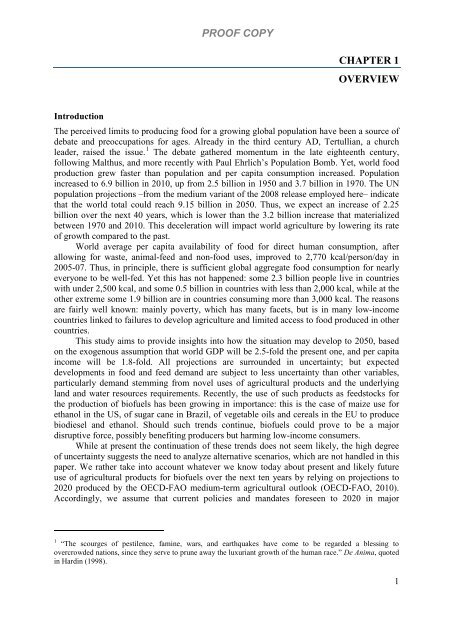World agriculture towards 2030/2050: the 2012 revision - Fao
World agriculture towards 2030/2050: the 2012 revision - Fao
World agriculture towards 2030/2050: the 2012 revision - Fao
Create successful ePaper yourself
Turn your PDF publications into a flip-book with our unique Google optimized e-Paper software.
PROOF COPY<br />
CHAPTER 1<br />
OVERVIEW<br />
Introduction<br />
The perceived limits to producing food for a growing global population have been a source of<br />
debate and preoccupations for ages. Already in <strong>the</strong> third century AD, Tertullian, a church<br />
leader, raised <strong>the</strong> issue. 1 The debate ga<strong>the</strong>red momentum in <strong>the</strong> late eighteenth century,<br />
following Malthus, and more recently with Paul Ehrlich’s Population Bomb. Yet, world food<br />
production grew faster than population and per capita consumption increased. Population<br />
increased to 6.9 billion in 2010, up from 2.5 billion in 1950 and 3.7 billion in 1970. The UN<br />
population projections –from <strong>the</strong> medium variant of <strong>the</strong> 2008 release employed here– indicate<br />
that <strong>the</strong> world total could reach 9.15 billion in <strong>2050</strong>. Thus, we expect an increase of 2.25<br />
billion over <strong>the</strong> next 40 years, which is lower than <strong>the</strong> 3.2 billion increase that materialized<br />
between 1970 and 2010. This deceleration will impact world <strong>agriculture</strong> by lowering its rate<br />
of growth compared to <strong>the</strong> past.<br />
<strong>World</strong> average per capita availability of food for direct human consumption, after<br />
allowing for waste, animal-feed and non-food uses, improved to 2,770 kcal/person/day in<br />
2005-07. Thus, in principle, <strong>the</strong>re is sufficient global aggregate food consumption for nearly<br />
everyone to be well-fed. Yet this has not happened: some 2.3 billion people live in countries<br />
with under 2,500 kcal, and some 0.5 billion in countries with less than 2,000 kcal, while at <strong>the</strong><br />
o<strong>the</strong>r extreme some 1.9 billion are in countries consuming more than 3,000 kcal. The reasons<br />
are fairly well known: mainly poverty, which has many facets, but is in many low-income<br />
countries linked to failures to develop <strong>agriculture</strong> and limited access to food produced in o<strong>the</strong>r<br />
countries.<br />
This study aims to provide insights into how <strong>the</strong> situation may develop to <strong>2050</strong>, based<br />
on <strong>the</strong> exogenous assumption that world GDP will be 2.5-fold <strong>the</strong> present one, and per capita<br />
income will be 1.8-fold. All projections are surrounded in uncertainty; but expected<br />
developments in food and feed demand are subject to less uncertainty than o<strong>the</strong>r variables,<br />
particularly demand stemming from novel uses of agricultural products and <strong>the</strong> underlying<br />
land and water resources requirements. Recently, <strong>the</strong> use of such products as feedstocks for<br />
<strong>the</strong> production of biofuels has been growing in importance: this is <strong>the</strong> case of maize use for<br />
ethanol in <strong>the</strong> US, of sugar cane in Brazil, of vegetable oils and cereals in <strong>the</strong> EU to produce<br />
biodiesel and ethanol. Should such trends continue, biofuels could prove to be a major<br />
disruptive force, possibly benefiting producers but harming low-income consumers.<br />
While at present <strong>the</strong> continuation of <strong>the</strong>se trends does not seem likely, <strong>the</strong> high degree<br />
of uncertainty suggests <strong>the</strong> need to analyze alternative scenarios, which are not handled in this<br />
paper. We ra<strong>the</strong>r take into account whatever we know today about present and likely future<br />
use of agricultural products for biofuels over <strong>the</strong> next ten years by relying on projections to<br />
2020 produced by <strong>the</strong> OECD-FAO medium-term agricultural outlook (OECD-FAO, 2010).<br />
Accordingly, we assume that current policies and mandates foreseen to 2020 in major<br />
1 “The scourges of pestilence, famine, wars, and earthquakes have come to be regarded a blessing to<br />
overcrowded nations, since <strong>the</strong>y serve to prune away <strong>the</strong> luxuriant growth of <strong>the</strong> human race.” De Anima, quoted<br />
in Hardin (1998).<br />
1









